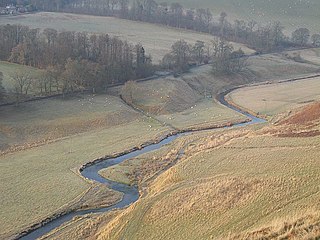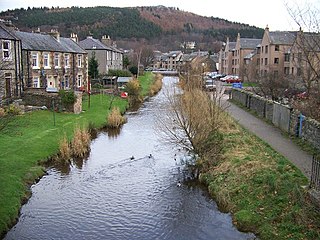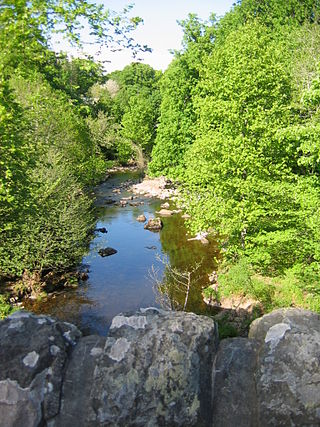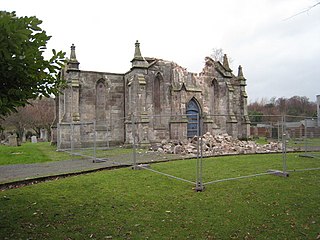Gallery
- Holiday cottages
- Disused railway line, Redscarhead
- Monument to George Meikle Kemp
- Eddleston Water
Redscarhead is a village in the Scottish Borders area of Scotland, off the A703, by the Eddleston Water, and close to Cringletie.
In the village is a memorial to George Meikle Kemp, the architect who designed the Scott Monument in Edinburgh.

Lothian is a region of the Scottish Lowlands, lying between the southern shore of the Firth of Forth and the Lammermuir Hills and the Moorfoot Hills. The principal settlement is the Scottish capital, Edinburgh, while other significant towns include Livingston, Linlithgow, Bathgate, Queensferry, Dalkeith, Bonnyrigg, Penicuik, Musselburgh, Prestonpans, Tranent, North Berwick, Dunbar, Whitburn and Haddington.

The Lammermuirs are a range of hills in southern Scotland, forming a natural boundary between East Lothian and the Borders. The name "Lammermuir" comes from the Old English lambra mōr, meaning "moorland of the lambs".

The Scott Monument is a Victorian Gothic monument to Scottish author Sir Walter Scott. It is the second-largest monument to a writer in the world after the José Martí monument in Havana. It stands in Princes Street Gardens in Edinburgh, opposite the former Jenners building on Princes Street and near Edinburgh Waverley Railway Station, which is named after Scott's Waverley novels.

George Meikle Kemp was a self-taught Scottish architect who designed and built the Scott Monument in Edinburgh, Scotland. The poorly educated son of a shepherd, showing talents in woodworking as a child, he was apprenticed to a joiner and millwright.

Belses is a village on the Ale Water, in the Scottish Borders area of Scotland the former Selkirkshire. It is situated close to Old Belses, and lies south of St Boswells, west of Jedburgh, north of Hawick, and east of Selkirk.

The Lyne Water is a tributary of the River Tweed that rises in the Pentland Hills of southern Scotland at Baddinsgill Reservoir. It runs through West Linton and Romannobridge, passes Flemington and Lyne Station and enters the Tweed west of Peebles. It floods regularly in winter and occasionally in summer. There is free fishing above Flemington Bridge, and below Flemington fishing in the river is administered by the Peebles fishing authority.

Eddleston is a small village and civil parish in the Scottish Borders area of Scotland. It lies 4 miles (6.4 km) north of Peebles and 9 miles (14 km) south of Penicuik on the A703, which passes through the centre of the village. Nearby is the Great Polish Map of Scotland, a large terrain map. The Eddleston Water runs through the village.

Prestonkirk Parish Church is a Church of Scotland parish church at East Linton, in the parish of Traprain, East Lothian, Scotland, UK, close to Preston Mill, Smeaton, Phantassie, and the River Tyne.

Preston Mill is a watermill on the River Tyne at the eastern edge of East Linton on the B1407 Preston Road, in East Lothian, Scotland, UK. It is situated close to Prestonkirk Parish Church, the Smeaton Hepburn Estate, Smeaton Lake, and Phantassie Doocot. It is a Category A listed building.

Leader Water is a small tributary of the River Tweed in Lauderdale in the Scottish Borders. It flows southwards from the Lammermuir Hills through the towns of Lauder and Earlston, joining the River Tweed at Leaderfoot.

Bonkyl Church is a Church of Scotland kirk situated at grid reference NT808595 5 miles northeast of Duns in the old county of Berwickshire. The nearest hamlet is Preston just over 2 miles to the south-west.

Lyne is a small village and civil parish in the Scottish Borders area of Scotland, 4 miles (6.4 km) west of the market town of Peebles; it lies off the A72, in the old county of Peeblesshire and has an area of about 4 square miles (10 km2).
Press Castle is a village with 17th-century manor house and country estate in the Scottish Borders, 2m (3 km) west of Coldingham, by the Ale Water. NT871654.

Eddleston Water is a small river north of Peebles, in the Scottish Borders area of Scotland which joins the River Tweed at Peebles. It is also known locally as "The Cuddy".

The Dye Water is a river in the Lammermuir Hills in the Scottish Borders area of Scotland. It rises in the Hope Hills, continues along the East Lothian boundary, a mile north east of Seenes Law, then east to Longformacus. The Dye Water joins the Whiteadder Water and completes its 12.5 mile journey.

Cranshaws is a village on the B6355 road, near Duns, in the Scottish Borders area of Scotland, in the former Berwickshire.

Cringletie is a Scottish Baronial house by the Eddleston Water, around 3 kilometres (1.9 mi) south of Eddleston in the Scottish Borders area of Scotland, in the former Peeblesshire. Designed by David Bryce and built in 1861, the house is a Category B listed building. Since 1971 it has been operated as a country house hotel.
Darnhall Mains is a farm and settlement off the A703, near Eddleston and the Eddleston Water in the Scottish Borders area of Scotland, in the former Peeblesshire.

Millburn Church is a ruined former church in Renton, West Dunbartonshire, Scotland. It was built in 1845 for the Free Church of Scotland in the Gothic style. It is a category A listed building, and is on the Buildings at Risk Register for Scotland. The architect is thought to have been John Thomas Rochead, though it has also been attributed to George Meikle Kemp, architect of the Scott Monument. The church was disused by 1985, when it was threatened with demolition. It remained empty despite several plans for restoration, and the roof collapsed in the late 1990s. In 2006 a storm blew down the steeple of the building, and in 2009 a further application to demolish the building was lodged. The application was opposed locally, and was withdrawn in 2011. Two of Robert Burns' nieces are buried in the kirkyard.